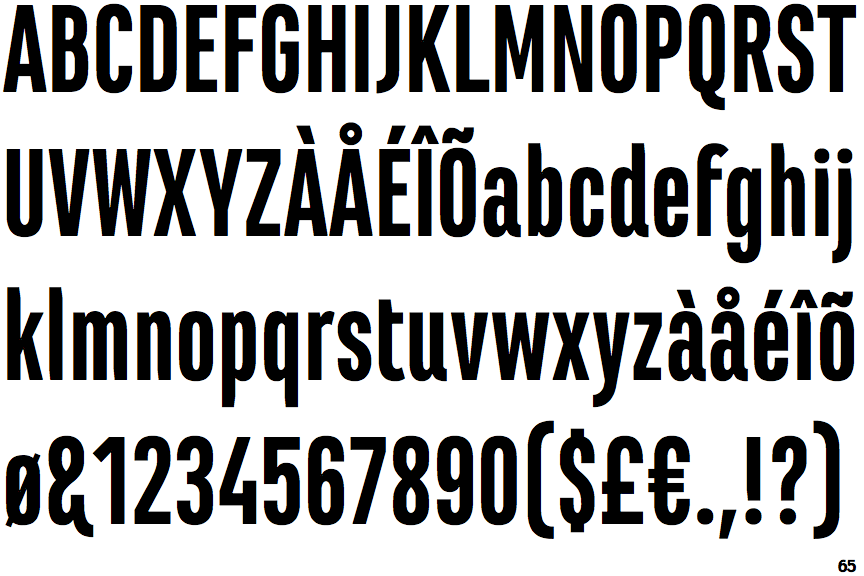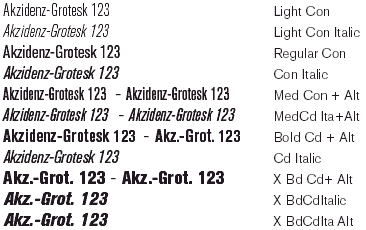

This gives a sense of simplicity and an absence of the adornment and flourishes seen in the more decorative sans-serifs of the late nineteenth century influenced by the Art Nouveau style. Like most sans-serifs, Akzidenz-Grotesk is 'monoline' in structure, with all strokes of the letter of similar width. The name may have reflected the "primitive" feel of sans-serifs, or their roots in archaic Greek and Roman inscriptions, and by the late nineteenth century was commonly used to mean "sans-serif", without negative implication. It was introduced by the London type-founder William Thorowgood as the name for sans-serifs in the specimen books of his Fann Street Foundry around 1830. Grotesque (German: Grotesk) was a standard term that had become popular in the first half of the nineteenth century for sans-serifs. The origin of the word is Latin accidentia, defined by Lewis and Short as "that which happens, a casual event, a chance". A modern German-language dictionary describes it as work such as advertisements and forms.


Both words were everyday, descriptive terms for typefaces of the time in the German language.Īkzidenz means some occasion or event (in the sense of "something that happens", not in the sense of a high-class social event or occasion) and was therefore used as a term for trade printing Akzidenzschrift was by the 1870s a generic term meaning typefaces intended for these uses.

It has sometimes been sold as Standard or Basic Commercial in English-speaking countries, and a variety of digital versions have been released by Berthold and other companies.Īkzidenz-Grotesk is often translated into English as "jobbing sans-serif", "jobbing" in the sense of "used for jobs". Its simple, neutral design has also influenced many later typefaces. Relatively little-known for a half-century after its introduction, it achieved iconic status in the post-war period as the preferred typeface of many Swiss graphic designers in what became called the 'International' or 'Swiss' design style which became popular across the Western world in the 1950s and 1960s. Originating during the late nineteenth century, Akzidenz-Grotesk belongs to a tradition of general-purpose, unadorned sans-serif types that had become dominant in German printing during the nineteenth century. "Akzidenz" indicates its intended use as a typeface for commercial print runs such as publicity, tickets and forms, as opposed to fine printing, and "grotesque" was a standard name for sans-serif typefaces at the time.
Akzidenz grotesk be bold cn series#
In 2001 Lange helped Berthold complete the AG series with the additions of AG light italic, Super Italic, light condensed, condensed, medium condensed, extrabold italic, light extended italic, extended italic and medium extended italic.Akzidenz-Grotesk is a sans-serif typeface family originally released by the Berthold Type Foundry of Berlin. Lange was instrumental in developing the Akzidenz-Grotesk program at Berthold in the 1950s and 1960s. Under the direction of Günter Gerhard Lange, Berthold added AG Medium Italic (1963), AG ExtraBold (1966), AG Italic (1967), AG ExtraBold Condensed & Italic (1968), AG Super (1968). In the 1950s Günter Gerhard Lange, then art director at Berthold, began a project to enlarge the typeface family, adding a larger character set, but retaining all of the idiosyncrasies of the 1898 face. The Theinhardt foundry later merged with Berthold and also supplied the regular, medium and bold weights. Originally named “Accidenz-Grotesk” the design originates from Royal Grotesk light by royal type-cutter Ferdinand Theinhardt. Berthold first published Akzidenz-Grotesk in 1898.


 0 kommentar(er)
0 kommentar(er)
